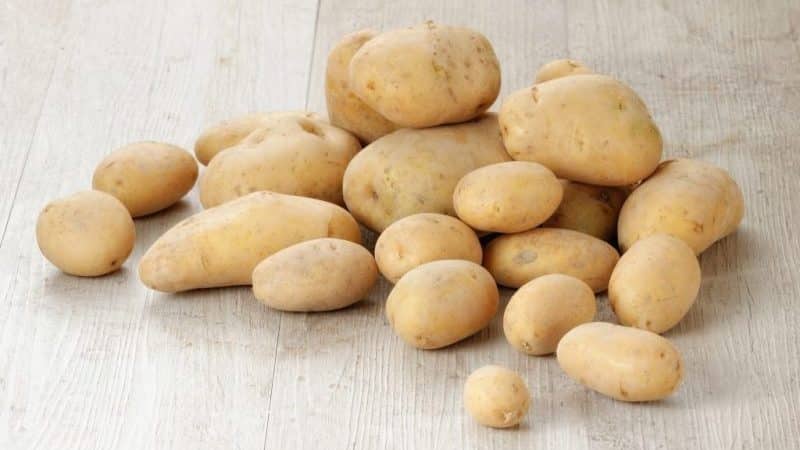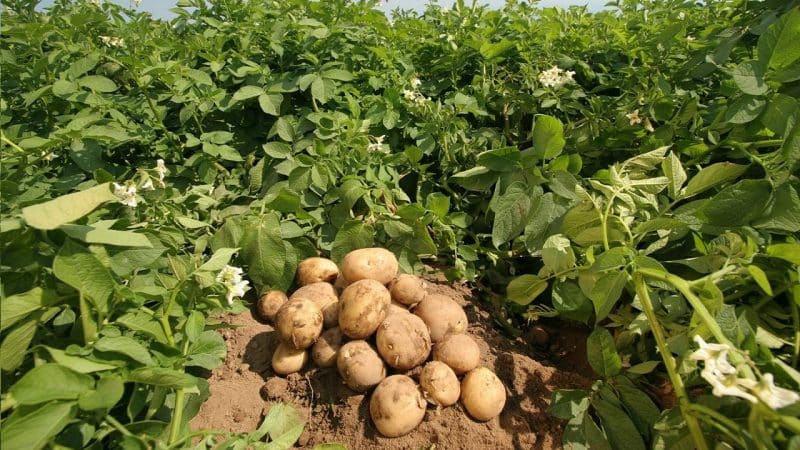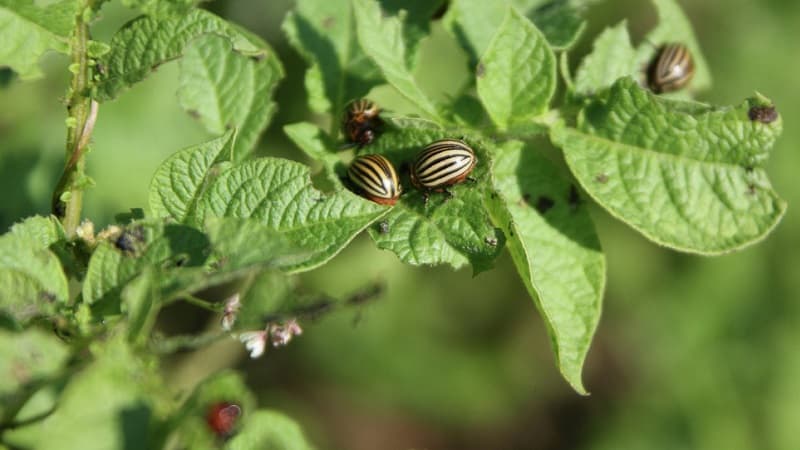Young but promising German potato variety “Krona”: description and reviews
Crohn's potatoes are a promising offer from German breeders. The variety is unpretentious, takes root in any climatic conditions and pleases with its yield. Large juicy potatoes are great for preparing first and second courses. They grow it as if it were for personal use. use, and for sale.
Description of the variety
Krona potatoes are a mid-early table variety. Its yield is from 430 c/ha, vegetables are stored for a long time and contain a small amount of starch - up to 12%. The variety is unpretentious in care and tolerates short-term drought well. It can grow without fertilizers, but feeding will not hurt to collect large and high-quality tubers.
On a note. Potatoes contain about 80% water and are rich in vitamins and beneficial minerals. It also contains a lot of provitamin A, which is necessary to support vision.
Origin and development
The variety Krona (Krone) was bred by the German breeding company Bavaria-Saat GBR. This agrotechnical enterprise has been creating new varieties and propagating them since 1987. The company has released about 15 varieties of potatoes that can satisfy the highest consumer demands.
Since Krona potatoes are highly resistant to temperature changes and lack of moisture, they are actively cultivated in many regions of our country.

Distinctive features
Main characteristics of this variety:
- the size of the vegetables is average, weight about 100-130 g;
- the shape of the potato is oval, with a smooth top;
- tubers are neat, balanced in weight and size;
- the shell is yellow, plain, thin and smooth;
- eyes are superficial, small;
- the flesh is yellow;
- starch content does not exceed 12%;
- high content of fiber, proteins, carotene and vitamins.
Description and characteristics of the plant and crop
Plants of this variety are slightly spreading, the stems are erect. The root system is well developed and fibrous. The small leaves are dark green in color. The inflorescence consists of white flowers, and no seeds are formed at the end of flowering - this is another feature of the variety.
Crohn's potatoes do not degenerate - varietal qualities are preserved and transmitted from the mother's planting material to the next generation. From 10 to 15 tubers are formed under each bush; there are practically no small ones.
Productivity
The Krona variety is a mid-early variety - vegetables ripen 100 days after landings. The yield is high; depending on climatic conditions, vegetable growers harvest from 430 to 650 c/ha.
Interesting. In total, there are about 4 thousand varieties of potatoes in the world.
How to grow this variety
Although the variety is unpretentious, proper care will only benefit it. Compliance with all rules and recommendations is the key to a rich harvest.
Dates, scheme and rules of planting
The best predecessors for potatoes are carrots, cabbage, legumes and green manure.. In the area where nightshades were grown, there is a risk of common diseases.
The best soil for planting is black soil and sandy loam. In the fall, before plowing, organic fertilizers are applied to the soil. If it is not possible to do this before winter, in the spring add rotted cow manure, peat or ash directly to the holes - in this case, frequent feeding will not be needed.
2-3 weeks before planting, the seed material is germinated: placed in a bright, warm room, pre-treated with a growth stimulant, for example, Epin. One ampoule (0.25 ml) of the drug is diluted in 400 ml of water and sprayed onto the tubers. One ampoule is enough to spray 200 tubers.
For planting, choose healthy, medium-sized seed material. When the air temperature remains at + 10 ° C, they are embedded in the ground.
Planting pattern:
- leave a distance of at least 30 cm between plants;
- the width between rows is maintained at about 60-70 cm;
- the seeds are deepened by 5-8 cm.
On a note. The most suitable planting method for the Crown is considered to be planting on ridges.
Care

To protect plants from sudden frosts, retain moisture during drought, and provide shelter from sunlight, bushes are hilled. During the entire growing season, the event is performed twice:
- the first time when the sprouts reach 15-18 cm;
- the second time 20 days after the first.
Crohn's potatoes are tolerant of short-term drought, but require moderate irrigation during bud formation. Due to lack of moisture, small tubers are formed. During the entire growing season, plants are irrigated 2-3 times. Water at the root, since water getting on the foliage will increase the risk of late blight.
Soil aeration is the key to strong crop immunity. The event promotes the formation of a powerful root system and the ripening of large potatoes. The row spacing is loosened after each plant moistening to prevent the soil from becoming crusty. During the entire growth period of the crop, at least 2-3 loosenings are carried out.
The soil is also freed from weeds. Weeding begins even before germination.The area is cleared of weeds at the time of hilling, and also as necessary.
Crohn's potatoes do not need frequent feeding. Responds well to mineral phosphorus-potassium fertilizers, for example, "Potassium Monophosphate", "Agrofoska" or "Ecoplant". Organic matter is added during planting.
Advice. To reduce the growth of tops on the site, avoid the application of nitrogen-containing fertilizers.
Nuances of cultivation and possible difficulties, diseases and pests
In hot weather, mulch the beds to preserve moisture in the soil. For this purpose, straw, grass or peat bedding is used. This type of shelter is also used to protect plantings from sudden cold weather.
Growing Krona is practically no different from cultivating other varieties. Difficulties can only come from possible diseases or pest attacks.
Common potato scab is a fairly common disease. Affected tubers retain their presentation for a much shorter period of time, and their taste deteriorates. The disease appears during dry seasons, when soil heated to +25 ... +27°C with a pH level below 5.5 lacks moisture. The disease mainly affects tubers, spreading less frequently to stolons and roots. If the crop is sick with scab, use the drug "Mancozeb" (1.2-1.6 kg of product per hectare of plantings, dissolved in water and sprayed).
Golden nematode is one of the most common and dangerous potato diseases. Tubers either do not form at all or are underdeveloped. The plants themselves are significantly behind in development. The cause of the disease is small worms - nematodes, the size of which barely reaches 1 mm. Young spherical females are painted white.Over time, the color turns yellow, gradually turning into brown tones. The golden nematode is destroyed with the drug “Fitoverm”. The product is used in dry or hot weather.

The most common pests:
- Aphid. These are small insects whose length reaches 3.5 mm. Among them there are individuals with and without wings. The pest is found everywhere. Potato aphids are gotten rid of with insecticides such as “Force”, “Grom 2” or “Regent”.
- Colorado beetle is a representative of the leaf beetle family. The pest has an oval body 8-15 mm long and about 7 mm wide. The larvae are orange with black spots. The body of an adult insect is covered with hard elytra with black and yellow stripes. The Colorado potato beetle is controlled by spraying the area with Marshall, Sumicidin or Colorado.
- Medvedka is a large insect (up to 8 cm) that digs holes in the ground and feeds on potatoes. It belongs to the Orthoptera family and is capable of flying short distances. The mole cricket is destroyed by treating the plantings with Medvetsid or Medvetox. Some summer residents use Regent or Fenaskin + products.
- Cicadas - These are medium-sized pests (1-3 cm), which are similar to jumping butterflies. During the day, insects hide in anthills, and at night they crawl to the surface and drink plant sap. Affected potato bushes are treated with insecticides such as Akarin, Vizcaya, Calypso or Proteus.
Collection, storage and use of crops
Seven days before harvest, all tops are cut off. This allows vegetables to get the necessary nutrients and increases their nutritional value. After a week, the potatoes are dug up with a shovel or walk-behind tractor.
The collected tubers are dried in the sun (no more than 2 hours), sorted and stored in a room with an air temperature of about +5...+10°C and a humidity of no more than 90%. The harvest is stored in wooden boxes, bags, nets in the cellar or basement.
Tubers are placed in boxes with small holes. The layer should not exceed 0.5 m so that the lower vegetables are saturated with oxygen and excess moisture evaporates. Containers with the harvest are placed on pallets or planks at a short distance from the walls.
The condition of the potatoes is checked monthly and spoiled tubers are removed so that rotting does not spread to other vegetables. The room is regularly ventilated. The shelf life of this grade is 96% if there is no condensation at the storage location.
Crohn's potatoes work well in French fries, baking, frying, and even freezing mixed vegetables. At cooking The potatoes remain whole, so they are used to make salads. Heat treatment only enhances the taste and aroma of vegetables.
Attention! If the potatoes have turned green, it is better not to eat them. In such vegetables, under prolonged exposure to sunlight, a toxic substance is produced - solanine.
Advantages and disadvantages of the variety
Advantages of Crohn's potatoes:
- excellent taste of vegetables;
- the versatility of potatoes in cooking;
- high productivity;
- excellent keeping quality;
- early and friendly ripening of tubers;
- strong immunity to diseases;
- transportability of vegetables;
- drought resistance;
- possibility of growing in different climatic conditions;
- good presentation of tubers;
- undemanding culture for care.
Flaws:
- the capriciousness of the variety in relation to the soil structure;
- intolerance to excess irrigation.
For which regions is it best suited?
The variety is suitable for cultivation in all regions of Russia, as the crop adapts well to temperature changes. In conditions favorable for potatoes, more crops are simply harvested.
Read also:
What are the benefits of potato juice for hair and how to use it correctly.
Unpretentious to grow and highly productive potato variety El Mundo.
Farmer reviews
Summer residents and experienced farmers speak mostly positively about the Krona variety. The culture grows well in the vast majority of regions of Russia.
Olga, Moscow: «Last year I grew potatoes called Krona. The yield pleased me, I didn’t even expect it. I also liked the taste of vegetables. I prepared various dishes from potatoes and simply boiled them as a side dish. The vegetables were stored for several months and during this entire period there were practically no spoiled tubers. The variety has absorbed all the positive qualities. The planting material is excellent, I recommend it to all gardeners.”
Dmitry, Volgograd: “I bought seed material of the Krona variety from a neighbor, and he praised it very much. I planted potatoes in almost pure clay, because there was no other place. I was pleased with the result; good potatoes grew. The vegetables are smooth and even, as in the photo. I also liked the taste of vegetables, 5 stars. Now this is my favorite variety. Next year I’ll plant Krona again, and I’ll be distributing planting material to my neighbors myself.”
Natalya, Saransk: “I’ve been involved in vegetable growing for about 15 years now. I’m always experimenting with new varieties of potatoes. That year I planted Corona. The variety turned out to be quite productive. The plants did not get sick. The vegetables ripened in about 90 days. The potatoes don't get soggy and hold their shape.I used it to make chips and French fries for the kids.”
Conclusion
Many gardeners prefer Crohn's potatoes for their excellent taste. Vegetables are not watery and retain their shape when cooked. Due to their low starch content, potatoes do not darken when cut. Vegetable growers also choose this variety for its low maintenance requirements and high yield. Potatoes are grown both by owners of small plots and by farmers for industrial purposes.